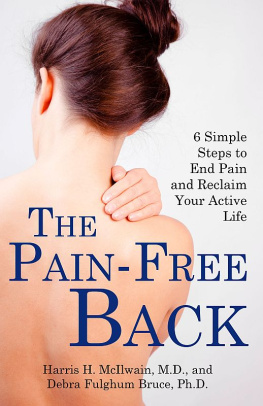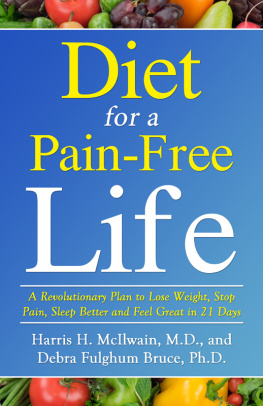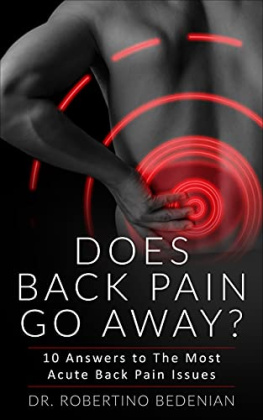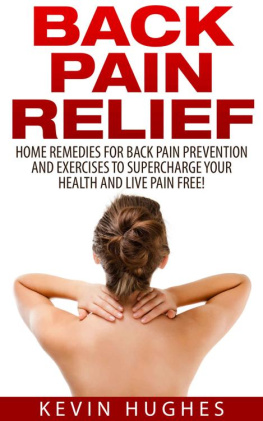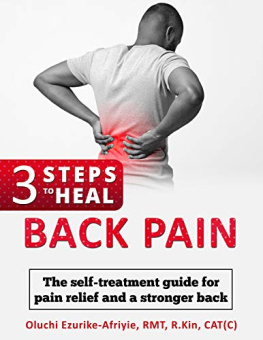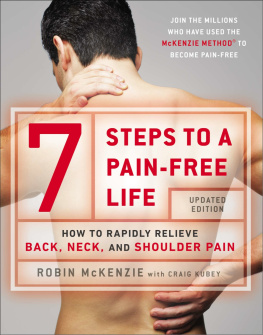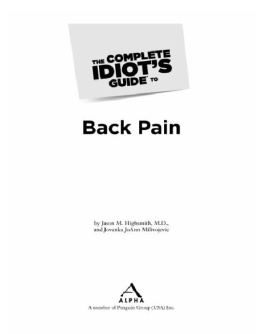Also by Harris H. McIlwain, M.D.,
and Debra Fulghum Bruce, Ph.D.
Pain-Free Arthritis
The Fibromyalgia Handbook
Stop Osteoarthritis Now
Winning with Heart Attack
Winning with Back Pain
Winning with Chronic Pain
Winning with Osteoporosis
The 50+ Wellness Program
The Super Calcium Counter
The Unofficial Guide to Conquering Impotence
Bone Boosters
The Osteoporosis Cure
Super Aspirins
Also by Debra Fulghum Bruce, Ph.D.
The 24-Hour Turnaround
Miracle Touch
Overkill
The Sinus Cure
Making a Baby
Eat Right to Stay Young
The Snoring Cure
The Unofficial Guide to Conquering Impotence
The Unofficial Guide to Alternative Medicine
Breathe Right Now
The Pain-Free Back

Diversion Books, New York
Contents
Diversion Books
A Division of Diversion Publishing Corp.
80 Fifth Avenue, Suite 1101
New York, New York 10011
www.DiversionBooks.com
Copyright 2012 by Harris McIlwain & Debra Bruce
All rights reserved, including the right to reproduce this book or portions thereof in any form whatsoever.
For more information, email .
First Diversion Books edition March 2012.
ISBN: 978-1-938120-03-9 (ebook)
1 3 5 7 9 10 8 6 4 2
STEP 1
The Pain-Free Back Exercise Program
When I first met Sandy Michaels, she had suffered from back pain for more than a decade. This forty-year-old software designer and mother of two had resorted to working at home because she could no longer endure the painful thirty-minute drive to her office. Each time her car stopped in traffic, Sandy experienced shooting pains throughout her back. Sitting at the computer workstation was painful, too, and Sandy was afraid she would need surgery, which is why she came in for an evaluation.
As we talked about her medical history, Sandy said that she had tried almost everything to resolve her back painfrom acupuncture, massage, and heat packs to herbal therapies, homeopathy, and even biofeedback. Nothing seemed to help. Even the strong narcotics her former doctor had prescribed were ineffective after she took them for a while. And the drugs made Sandy so exhausted she could not work or take care of her young children.
When I asked how often she exercised, Sandy was quick to respond, Not at all. She explained her fear of injuring her back even more and that she was very guarded in all her movements to avoid more pain. And, besides, she added, I blame exercise for my back pain, as I was first injured when I fell playing softball ten years ago.
Even though Sandy had such negative feelings about exercise, I convinced her that moving around with increased activity was the best waythe only wayto help her to feel relief. Exercise would allow her to reclaim her active life againa life without debilitating back pain and immobility. Sandy started the Pain-Free Back Exercise Program, which youll learn about in this step, and within three weeks she surprised herself with much less pain and greater mobility.
Start Your Pain-Free Back Diary
Using an inexpensive three-ringed notebook or PDA (Personal Data Assistant), you will keep a daily Pain-Free Back Diary throughout the 6 steps in this program. For Step 1, use the diary to record your daily exercises, including the type of exercise (stretching, strengthening, and conditioning), the time of day, the duration, and how you felt before, during, and after exercise. Also, write down how you feel after using the moist heat or ice applications on your back before and after exercise. Take your Pain-Free Back Diary (or PDA) to your next doctors visit, and review the feelings and any concerns you have experienced during and after exercise. Talk about exercise restrictions, if any, and ask if medications might help you to stay pain-free.
After two months on the Pain-Free Back Program, Sandy told me she was sleeping better, taking less medication, and had gone back to work at her office, giving her the much-needed social contact she was missing while working at home. She even joined the Y and started a regular water exercise program to keep her back strongand pain-free.
Sandy is just one of more than 100 million adult Americans who experience some degree of lower back pain each day. According to a new survey by the American Academy of Physical Medicine and Rehabilitation, more than half of those people say that back pain interferes with their daily activities. Ironically, of those who complained of back problems, only a small percentage said they have gone to a medical doctor for a proper diagnosis and treatment. In addition, while almost half of those surveyed believe surgery is the only answer to their problem, in reality surgery is needed in only about 5 percent of back pain cases.
Exercise and Your Back
If you are like most of my patients with back pain, you are tired of hurting and probably cringe when the word exercise is mentioned. Maybe you identify with my patient Kim, a young woman who injured her back during a step-aerobics workout. Even though Kim was a passionate athlete, she developed a real phobia about exercise, fearing shed reinjure her back again. Kim reasoned that if it hurt when she moved her back doing stretches, and it was not as painful when she didnt, then being less active would help to resolve the problem. Wrong!
Or, perhaps youre like forty-eight-year-old Mac, a high school science teacher, whose back pain occurred when he bent down to pick a paper clip off the floor. Overweight and underfit, Mac swore off exercise for months for fear that the slightest motion would cause his back to go out again. After all, if picking up a paper clip could cause this much pain and loss of work, he said, imagine what regular strength training or stretching might do.
When back pain patients like Kim and Mac come to our clinic, the first recommendation I make is, Exercise. I explain that in almost every situation, whether with injury or degenerative disease, most cases of back pain can be reducedand even stopped completelywith regular physical activity. Stretching, strengthening, and conditioning exercises can result in stronger muscles that support your spine and your bodys weight. And when your bodys skeleton is supported, you are less likely to suffer injury and pain. A number of excellent studies show that when back pain sufferers start a regular exercise program, including resistance exercise or strength training, they are more likely to have less pain, return to work, and be active again. These men and women are also less likely to need as much medical care for back problems if they continue to exercise. I like to tell my patients that if they start the regular Pain-Free Back Exercise Program, the chances are great that instead of making another trip to the doctor for more tests or medications, theyll soon be on the golf course or tennis court actively enjoying their lives.
The Cycle of Chronic Back Pain
When most people get back pain, they become less active. Many patients immediately go to bed for days, hoping to resolve the pain. They sit around instead of moving more and avoid using their muscles as much as possible. Because of this, the muscles that bolster the spinal column weaken. After avoiding exercise for weeks, the back can lose muscle tone and strength, feel tense or tight without any movement, and even begin to feel achy or hurt more for no reason at all.
Next page
